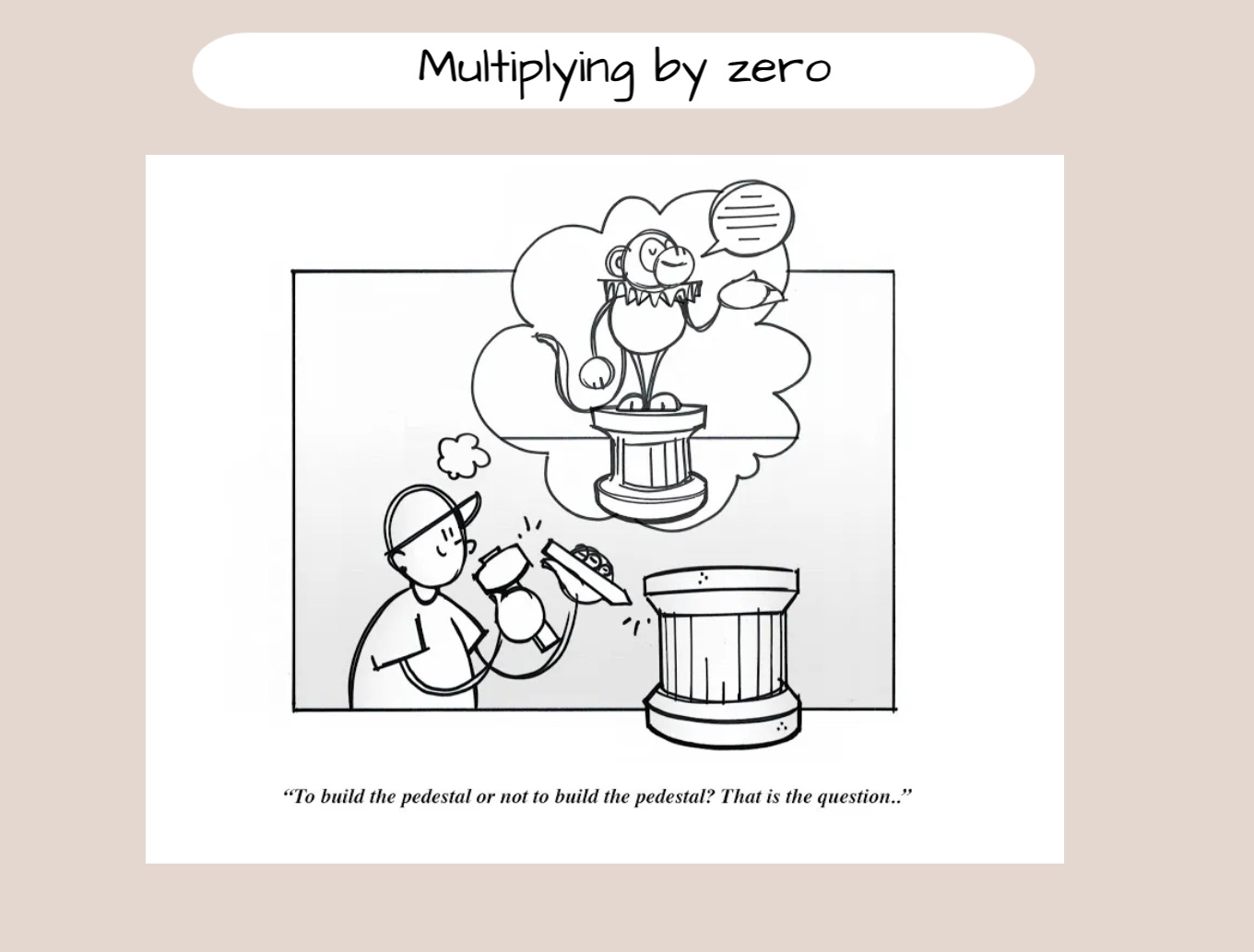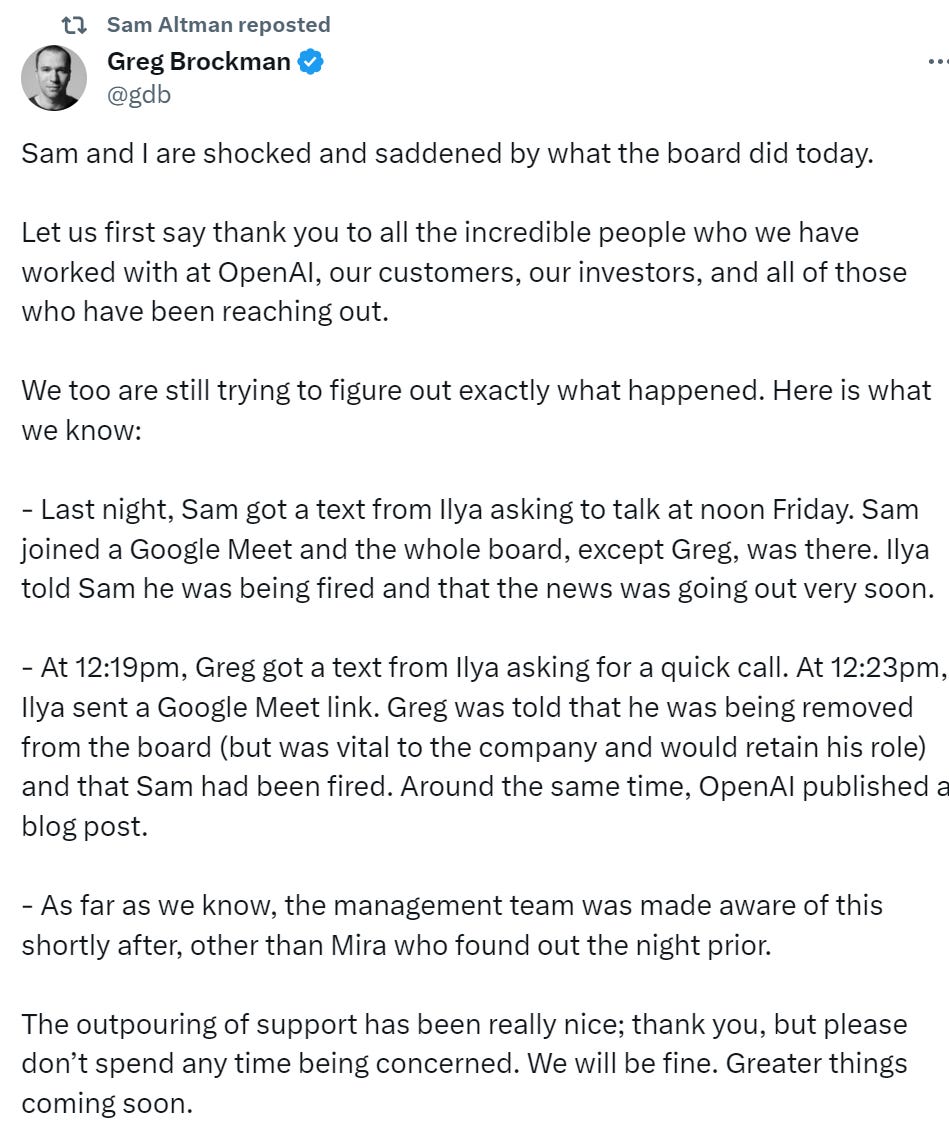Welcome to edition #33 of Food for Thought, my weekly newsletter. Every week I share five things:
One idea I’m thinking about
One thing I’m reading
One thing I’m listening to
One thing I’m watching
One quote I’m pondering
Apologies for missing last week’s edition - life got in the way!
One idea I'm thinking about: Multiplying by zero
One of the first things you will have learned in maths is that anything multiplied by zero is zero.
This is as true in life as it is in mathematics. Underlying this idea is the concept of multiplicative systems.
A chain is as strong as its weakest link
At Google X, the ‘moonshot factory’ of the tech giant, the mantra is #MonkeyFirst.
The idea is that if you want to train a monkey to stand on top of a pedestal and recite Shakespeare, you start by training the monkey, not by building the pedestal.
Anyone can build a pedestal, but very few can figure out how to teach a monkey the nuances of English literature.
Even if you build the most beautifully designed pedestal there ever has been, the ‘zero’ factor of the monkey will mean that you have made no progress towards the actual goal.
In contrast, in an additive system, each component adds together to create the final outcome. If you add zero to a string of huge numbers, the result will still be huge.
Take for example a family lunch, where different relatives each bring a dish. If your aunt accidentally puts salt instead of sugar into her famous pudding, there will be a problem. But the dinner still goes ahead. All the other dishes are still good to go.
The addition or subtraction of different components creates a different outcome but not a binary win/lose outcome like a multiplicative system.
Most businesses operate in multiplicative systems, but too often, think that they are operating in an additive one.
Many companies continually add features to their product while neglecting to focus on key issues such as listening to customer feedback or gradually moving towards profitability.
The infamous Pets.com spent millions on marketing and TV advertising without actually testing whether pet owners wanted to buy pet supplies online, resulting in one of the more public downfalls of the dot-com crash.
For this reason, identifying whether you are in a multiplicative or additive system is hugely important. If the whole system depends on one or two critical components, it is essential that you address these components first.
One thing I’m reading: Sam Altman and OpenAI
Last Friday, Sam Altman was suddenly fired as the CEO of OpenAI - the company behind ChatGPT.
A fellow Board member, Greg Brockman, was also fired from the board and posted the following on X:
Investors are reportedly furious, with Microsoft’s Satya Nadella (who has invested over US $13B in the company) said to be firmly by Altman’s side.
This is a story to watch, with rumours about Altman staging a counter-coup to return as CEO or starting another competitor with backing from current investors in OpenAI
One thing I’m listening to: The Interstitium
The latest episode of Radiolab explores the discovery of a new human ‘organ’. Scientists are calling it the interstitium - a network of fluid-filled spaces in tissue all over the body.
This network was only discovered for the first time a few years ago, thanks to the advent of new technology that allows living tissue to be examined microscopically while still in the body.
This interstitium could provide a bridge between Western medicine and Eastern medicine like ayurveda and acupuncture, which talk about the flow of energy or chi through the body.
There is also the potential to revolutionise cancer treatment. A current theory that is being tested is that cancers metastasize (move from one part of the body to another) through this interstitial fluid.
Scientists are beginning to understand the hallmarks of cells that make this journey, and coming up with ways to target them specifically, without bombarding healthy cells with chemotherapy. While this could change how cancer is treated, it will take years if not decades for the theory to be confirmed and put into practice.
One thing I’m watching: Mapping the ocean floor
In this video, Cleo Abram explores the scientific effort to map the ocean floor.
A couple of things stood out to me in the video.
The first is just how unfathomable the scale of the ocean is. The furthest a human has ever free dived is just 200m. At 1000m down, no sunlight at all penetrates the water. It’s just complete blackness, and you’re less than 10% of the way down.
The deepest spot is called Challenger Deep - at around 10,935m. If you put Mount Everest upside down here, there would still be over a mile of headroom left.
The second is how cool the methods are that we use to map the ocean. One method is to look at the shape of the waves. If there is a mountain on the ocean floor, the water above it will be slightly higher, because of the gravitational pull that the mountain exerts. So the surface of the water is ever so slightly shaped like the ocean floor.
We also use sonar beams that bounce back off the ocean floor to create more detailed maps.
Lastly, she discusses how some people are actually opposed to mapping the ocean floor because of what people might do with the information e.g., deep sea mining or using the data to start wars.
But I don’t think this a good enough reason stop the mapping. We should be responsible enough to handle the information properly. You can’t manage what you haven’t measured.
One quote I’m pondering:
“In the beginner’s mind, there are many possibilities, but in the expert’s there are few”
-Shunryu Suzuki




Very informative Saurabh!
Waiting to hear more abt Open AI, Chat GPT in your column.
Multiplying to zero (not by 0) is nothing, yet in permutations and combinations we have something called as 0! (0 Factorial) = 1. The idea of the factorial (in simple terms) is used to compute the number of permutations (combinations) of arranging a set of n numbers. It can be said that an empty set can only be ordered one way, so 0! = 1. (Zero as a quantity is non existent, it is not countable and yet we say an empty set having having nothing (surprisingly quantified!) is 1)).
And of course there are many other fascinating facts about 0.
Concept of Zero is intriguing.